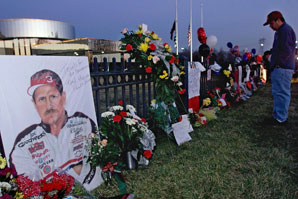NASCAR learned from tragedy to make racing safer
Those numbers alone showcase how quickly NASCAR has gone from a failing grade to the forefront of safety innovation within its top three series, avoiding a repeat of the 2001 Daytona 500 that ended with the loss of a legend. The Great American tragedy became the blackest cloud for a sport in which three drivers -- two with the legendary last names of Petty and Earnhardt -- were killed in nine months, a black cloud hanging over a sport trumpeted as family fare.
But in the wake of immeasurable sadness, those deaths were not in vain; a newer, safer sport of stock car racing has risen. There have been a few bumps in the road -- Carl Edwards' Talladega flip in April 2009 the most notable, injuring seven as the No. 99 Ford came perilously close to a disastrous ending inside the grandstands -- but better equipment, a proactive mentality and even a little dose of Lady Luck have fans forgetting the danger of watching a 3,500-pound stock car streak by within 100 feet.
"I don't really even think about that," says Corrine Webber of New Smyrna Beach, Fla., a longtime race fan, when asked if she worries about getting hurt. "I guess I just take for granted the tracks are safe."
"I have never felt unsafe," adds NASCAR supporter Matt Pool of Kannapolis, N.C. "Ever."
Those are bolder statements than you think these days, especially considering six open-wheel fans have been killed the last dozen years at two facilities stock cars visit: Charlotte and Michigan. In those instances, debris and a tire hurtled into the stands, the catchfence unable to stop the scary sight of shrapnel and a tire making it over the barrier. But while NASCAR will never be completely immune to such instances, what's great to see is an immediate reaction to minimize risk at all costs.
Take Talladega as an example. After the debris from Edwards' car raised catchfence questions, the speedway didn't hesitate to raise the height eight feet in time for the next Cup Series race there in October. The repair cost millions, but is there really any value one can put on a human life?
"Fan and competitor safety is always our top priority, and we work hard to ensure a safe and memorable experience for all our guests," says Talladega Chairman Grant Lynch, who didn't hesitate to hire an outside engineering firm last summer for recommendations. "Whenever our safety systems are tested across the ISC family, we and our sister tracks take the opportunity to closely examine how every element functioned to see if there is anything more we can or should be doing."
Independently-owned Pocono Raceway conducted a similar evaluation this year, with officials choosing to install energy-absorbing SAFER barriers for 2011 on the recommendation of experts at the University of Nebraska. Ironically, two accidents shortly thereafter showcased just why those fixes were needed: Kasey Kahne's No. 9 Ford was nearly launched outside the track in June and Elliott Sadler recorded the highest G Force hit in NASCAR history in August, smashing his car so hard into an inside guardrail that the engine broke off.
"It is very difficult to anticipate these types of accidents," said Pocono Raceway officials in written response to an SI.com question. "We have run 64 NASCAR Cup races before 2010 and never had an incident such as the Kasey Kahne [crash]."
It's true that forecasting these worst-case scenarios is about as easy as predicting the weather. But at least with the Car of Tomorrow, NASCAR has made it easier for the drivers to conduct those "experiments" without the fear of getting torn to pieces. From a wider cockpit to energy-absorbing "crumple zones," the new car may get competitive criticism but has accomplish the goal of a perfect safety record since debuting in 2007. And now, with the one questionable part replaced in March -- a rear wing many thought made it easier for a car to flip at Daytona and Talladega -- NASCAR has officially taken safety to the next level.
In fact, it's safe to say that's the least of people's problems with stock car racing these days in the face of a troubled point system, the struggles to fill the field, and passing become a luxury and not a requirement down the stretch.
"Fans realize that the sport is inherently dangerous," Pocono officials said in their statement. "But they also realize tracks would not stay in business if fan safety was not a paramount concern. They understand rules and regulations are in place to protect their safety."
It's a stark contrast to the Mojave Desert, where letting fans sneak up to the action unprotected is the main reason eight of them paid the ultimate price. But even though off-road racing and Cup racing take place at radically different venues, the first reaction from ISC facilities was to try to figure out ways in which all their tracks could double their vigilance on keeping fans safe.
"When something occurs elsewhere in the industry," adds Lynch, "we review the event closely with our facilities in mind to see if there are additional steps we need to take. We work very closely with NASCAR on safety and have implemented various systems at their recommendation over the past several years, such as SAFER walls, additional skid pads and others."
Too bad there's no cure yet on how to make the racing more competitive, too. But boring competition that gets all the drivers home in one piece is certainly better than watching the alternative -- a point NASCAR understands more than any other racing series.





